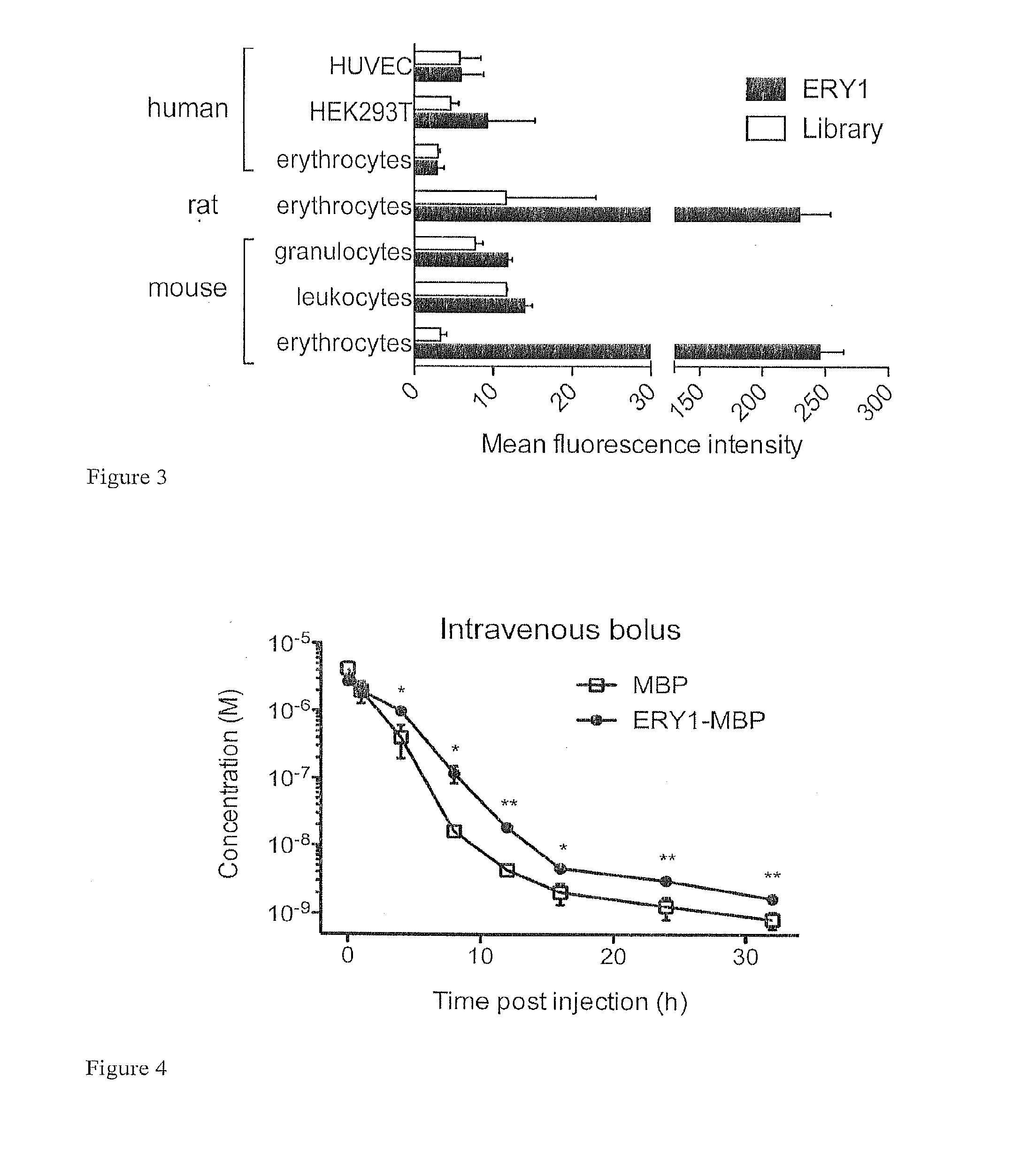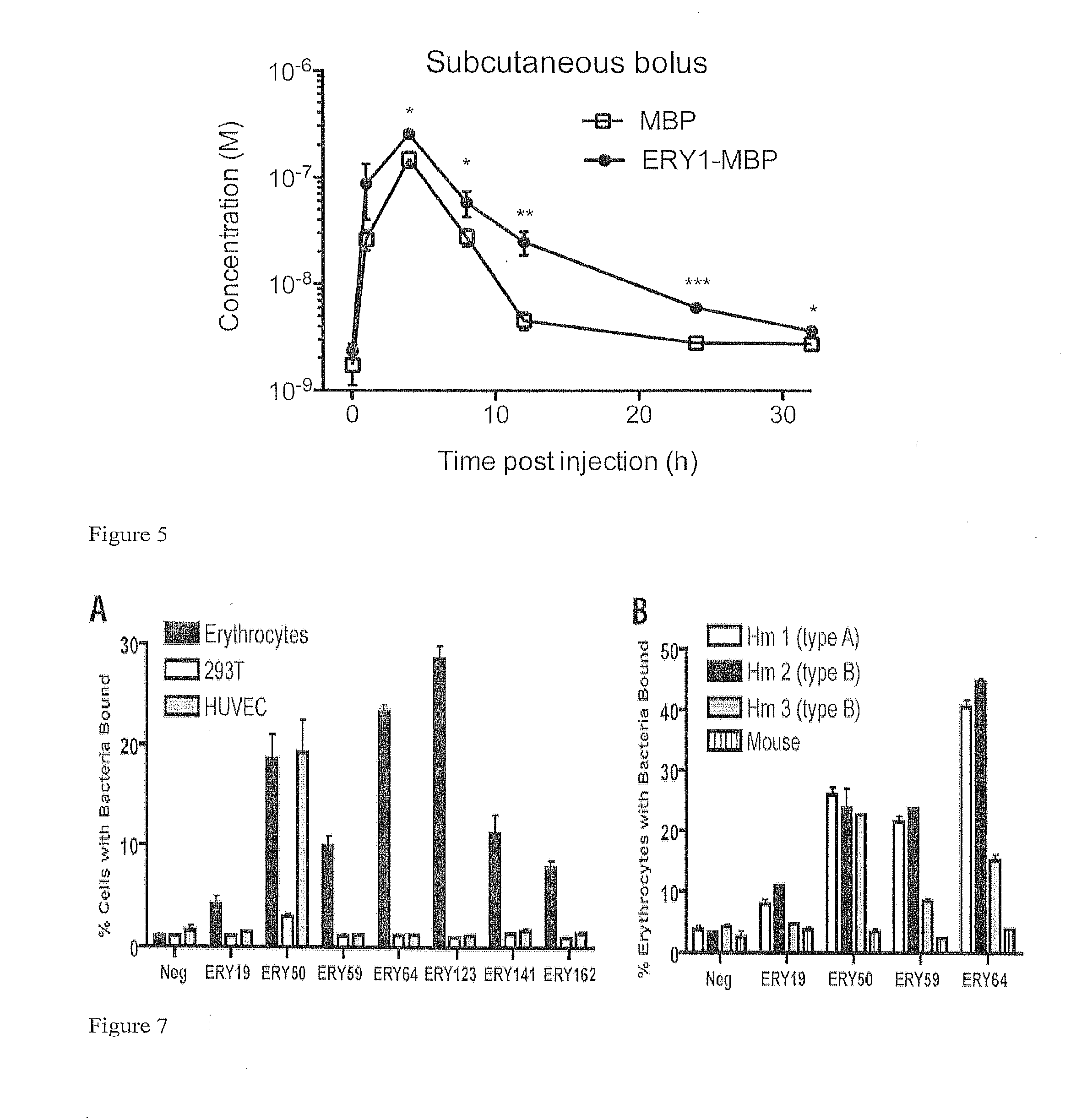Compositions for generating immune tolerance by targeting erythrocytes
a technology of erythrocytes and compositions, applied in the field of medical compositions, can solve problems such as and achieve the effect of blocking the blood supply to tumors
- Summary
- Abstract
- Description
- Claims
- Application Information
AI Technical Summary
Benefits of technology
Problems solved by technology
Method used
Image
Examples
example 1
Screening for Erythrocyte-Binding Peptides with Mouse Erythrocytes
[0122]The PhD naïve 12 amino acid peptide phage library commercially available from New England Biolabs (NEB) was used in the selection. In each round of screening, 1011 input phage were incubated with mouse erythrocytes in PBS with 50 mg / mL BSA (PBSA-50). After 1 h at 37° C., unbound phage were removed by centrifugation in PERCOLL (GE Life Sciences) at 1500 g for 15 min. A subsequent dissociation step was carried out in PBSA-50 in order to remove low-affinity binding phage. Dissociation duration and temperature were increased in later rounds of screening to increase stringency of the selection process. In round 1, phage binding was followed by a 2 min dissociation step at room temperature prior to washing and elution. In round 2, phage binding was followed by a 10 min dissociation at 37° C. In rounds 3 and 4, two separate and sequential dissociation steps were conducted at 37° C.: 10 min followed by 15 min in round 3...
example 2
Characterizing of Binding to Mouse Erythrocytes
[0123]Result: Microscopy confirmed that the ERY1 phage binds the erythrocyte cell surface without altering cell morphology and without cytoplasmic translocation. Fluorescence and phase contrast images reiterated the erythrocyte-binding capacity of ERY1 phage relative to the non-selected library. High-resolution confocal imaging revealed that ERY1 phage are distributed across the cell surface (as opposed to being clustered at a single site) and bind preferentially to the equatorial periphery of the cell surface, and that binding was homogeneous among erythrocytes (FIG. 1).
[0124]Method: For all samples sample, 1011 input phage were incubated with mouse erythrocytes in PBS-50. After 1 h at 37° C., unbound phage were removed by centrifugation at 200 g for 3 min. For regular fluorescence microscopy samples, cells were incubated with anti-M13 coat protein-PE antibody (Santa Cruz Biotechnology) at a 1:20 dilution in PBSA-5 for 1 h at room temp...
example 3
Characterizing the Molecular Target of Binding to Mouse Erythrocytes
[0125]Result: To search for the molecular target for the ERY1 peptide, affinity pull-down techniques using a biotinylated soluble peptide were employed; this method revealed glycophorin-A (GYPA) as the ERY1 ligand on the erythrocyte membrane. When whole erythrocytes were incubated with ERY1 peptide functionalized with biotin and a photoactivatable crosslinker, a single 28 kDa protein was conjugated with the peptide-biotin complex, as detected by a streptavidin Western blot (FIG. 2A). The reaction lysate was extensively washed and purified using streptavidin magnetic beads to ensure no unlabeled proteins from the erythrocyte lysate remained. As expected, the mismatch peptide failed to conjugate to any erythrocyte proteins. The mismatch peptide, PLLTVGMDLWPW (SEQ ID NO:2), was designed to contain the same amino acid residues as ERY1, and to match its hydrophobicity topography. Evidence of the apparent size of the inte...
PUM
| Property | Measurement | Unit |
|---|---|---|
| dissociation constant | aaaaa | aaaaa |
| dissociation constant | aaaaa | aaaaa |
| concentration | aaaaa | aaaaa |
Abstract
Description
Claims
Application Information
 Login to View More
Login to View More - R&D
- Intellectual Property
- Life Sciences
- Materials
- Tech Scout
- Unparalleled Data Quality
- Higher Quality Content
- 60% Fewer Hallucinations
Browse by: Latest US Patents, China's latest patents, Technical Efficacy Thesaurus, Application Domain, Technology Topic, Popular Technical Reports.
© 2025 PatSnap. All rights reserved.Legal|Privacy policy|Modern Slavery Act Transparency Statement|Sitemap|About US| Contact US: help@patsnap.com



